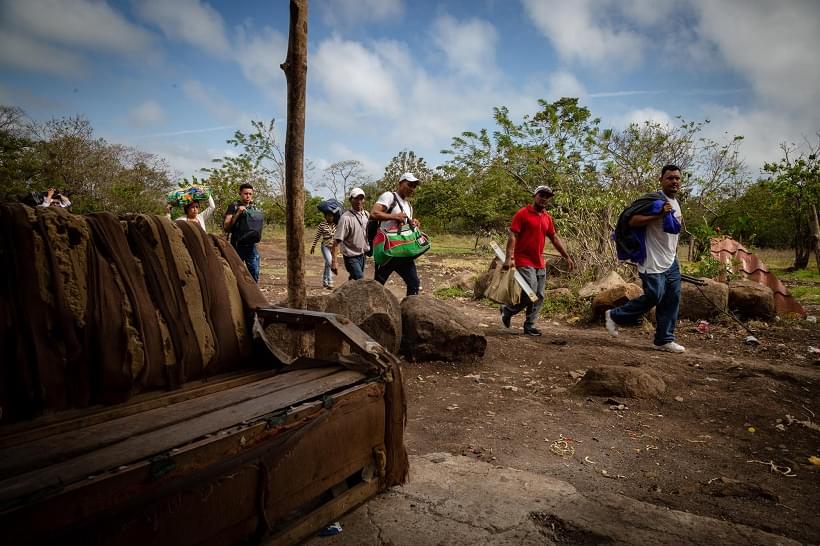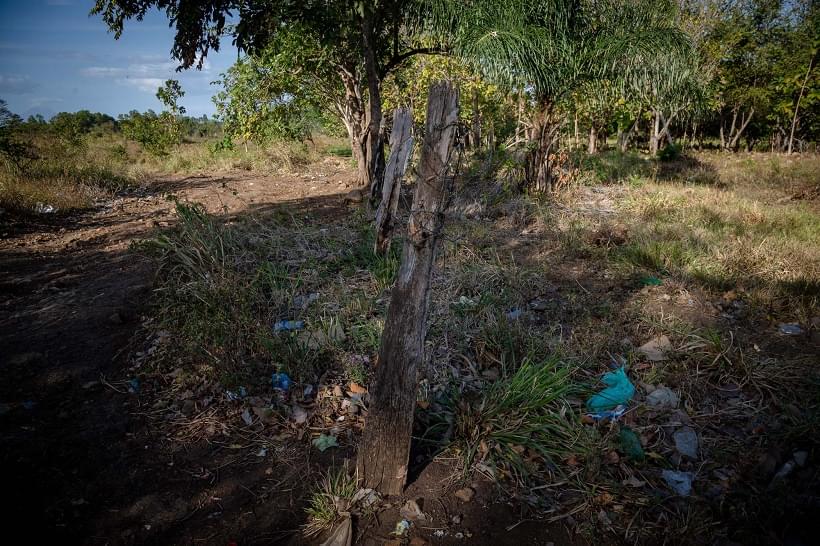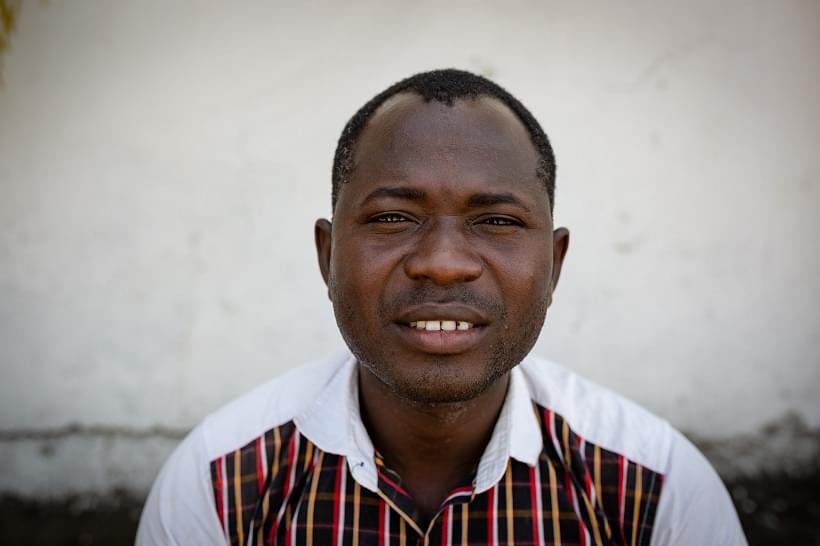
Cada vez que un carro estaciona a la orilla de la carretera panamericana, dos kilómetros antes de llegar al puesto fronterizo entre Costa Rica y Nicaragua, una docena de hombres caen como hormigas sobre azúcar. Abren puertas, se paran junto a las cajuelas y abordan a los pasajeros con frases como “déjeme ayudarle”, “le cargamos todo eso”, “dos mil colones por llevarle las maletas”.
“A los negritos también los ayudamos”, dice Óscar José Castillo Mendoza, un nicaragüense pequeño de cara tostada y vestido de pantalón marrón, camiseta verde y chancletas rosadas. Él y otros aquí les llaman “negritos” a los migrantes africanos.
Decenas de personas cruzan todos los días por senderos clandestinos hacia Nicaragua y viceversa por este punto de la frontera, cerca a Peñas Blancas (Costa Rica), evadiendo los controles migratorios de ambas naciones centroamericanas.
Es un flujo clandestino pero común, al menos hasta que una unidad de la policía costarricense se acerque. Entonces, la gente corre a esconderse en algún pequeño negocio o detrás de arbustos.
Quienes más transitan por estos caminos ilegales son los residentes de estos países. Sin embargo, desde hace cinco años el tránsito de cubanos y haitianos está creciendo aceleradamente. Entremezclados con ellos, o en grupos aparte, pasan centenares de personas que vienen desde África o Asia, algunas de ellas después de haber recorrido medio continente.
Muchos senderos clandestinos de Costa Rica hacia Nicaragua empiezan en los patios traseros de las casas cercanas a la frontera. Las familias ahí cobran un “peaje” por dejar pasar a quienes migran. Una sentencia costarricense del 2017 indica que el cobro era de unos US$15 en ese entonces.
Pero la ruta más conocida y transitada es “el callejón”. Es un sendero público por el que basta caminar un par de minutos para topar la cerca de alambres de púas que delimita la frontera.

De diciembre a abril es una zona polvorienta, con unos cuantos árboles marchitos y repleta de basura que dejan los caminantes. De mayo a noviembre, la senda se vuelve lodosa y algunos vecinos en el lado de Costa Rica, como María Estela Hurtado, aprovechan para ganar plata lavando pies.
Hurtado vive en la última casa del callejón, antes de la cerca. Ella vende tortillas cada mañana a quienes cruzan, o a quienes se desenvuelven en diferentes oficios en la carretera, como Castillo que carga maletas.
“Para serle franca y sincera, aquí pasa bastante gente, nicaragüenses, cubanos, africanos. Aquí pasa de todo”, dice en la puerta de su vivienda de madera.
Desde aquí se observa una caseta del Ejército de Nicaragua a unos 200 metros de distancia, por el mismo paso de tierra bien demarcado. Algunos militares están ahí para interceptar a los migrantes extrarregionales cuando cruzan, y llevarlos a la Dirección General de Migración y Extranjería de Nicaragua.
El gobierno de Nicaragua les cobra US$150 de salvoconducto para dejarlos pasar por el país. Le cobran el mismo monto hasta a un recién nacido. Así lo relataron vecinos de la frontera, migrantes y autoridades policiales de Costa Rica, a La Voz de Guanacaste, socio de la investigación transfronteriza Migrantes de Otro Mundo, en la que participaron CLIP y otros 16 medios periodísticos. Quisimos tener la versión oficial y detallada del gobierno nicaragüense, pero no hubo respuesta a las consultas enviadas vía correo electrónico. Tampoco hay información pública sobre este tema.
No es novedoso que Nicaragua cree obstáculos a quienes migran hacia Norteamérica. En 2015 y 2016, el gobierno de Daniel Ortega cerró sus fronteras y expulsó a decenas de africanos, haitianos y cubanos que querían continuar su camino hacia Estados Unidos. Esto dejó a migrantes que habían llegado a Costa Rica en varias oleadas, estancados por meses.
Hurtado cree que el gobierno nicaragüense puso esa “champa” (como le llama ella a la caseta) hace dos años, cuando vio la migración como una oportunidad de percibir ingresos. De hecho, si los cálculos de Hurtado y otras fuentes son certeros, la política del salvoconducto coincidió con la crisis política que se desató en ese país centroamericano en abril del 2018 y que dejó 328 muertos, según la Comisión Interamericana de Derechos Humanos, y provocó sanciones económicas por parte de Estados Unidos.
Este, dicen Hurtado y Castillo, el cargador de maletas, es el único paso “seguro” y libre para estos migrantes extracontinentales. Seguro, quizás, pero si los migrantes no tienen $150, no les permiten entrar.
Los otros trayectos son más recónditos y peligrosos, incluso más ocultos que los patios traseros de las casas. “Hay varios caminos y es difícil de controlar”, asegura Hurtado. “Pero por donde pasan más africanos es al lado del muro [refiriéndose a otro camino conocido]. Ahí los agarran los coyotes y hay asaltantes”.
El vicepresidente de la Asociación de Desarrollo de Peñas Blancas, conocido como “Macho Tigre” coincide con Hurtado. “Ellos llegan en buses en las noches y cruzan en las madrugadas por ‘el muro’, porque no tienen dinero. A veces con coyotes, a veces solos”, dice mientras cuenta su fajo de billetes nicaragüenses y ticos que le cambia a quienes transitan por su pulpería, cerca de la casa de Hurtado.
Para hacer el trayecto por “el muro”, los migrantes llegan metros antes del puesto de control migratorio costarricense y atraviesan una malla con un hueco del tamaño justo para que una persona cruce sin tener que agacharse. En el fondo, se ve una arbolada. Al continuar por ahí, topan eventualmente con un muro que deben saltar para caer en Nicaragua.
Unas vendedoras de refrescos cerca de ahí confirman lo que dice Hurtado: que cruzar es peligroso porque hay asaltantes.
Quizás lo intentan para evadir el pago de US$150 estipulado por el gobierno nicaragüense. O quizás, como dice Hurtado, ya le pagaron a alguien para que los pase por la frontera. “Hay coyotes que los traen desde Paso Canoas [frontera con Panamá]. Les vienen cobrando un montón de plata, y les dicen que no están dando salvoconducto [en Nicaragua]”.
Narin Burung, un nepalí de 23 años, le contó a los aliados de CLIP, que vivió la peor parte de su viaje, precisamente allí, después de atravesar la frontera de Costa Rica hacia Nicaragua, el 2 de julio del 2018.
“Caminamos por 36 horas sin comida y sin agua (...) La mafia era horrible. Violaban a las mujeres, saqueaban a los migrantes e incluso les robaban ropa. Escuchamos de un nepalí antes que nosotros que, cuando protestó, le dispararon en el estómago”, contó Burung.
“[Nicaragua] fue incluso peor que la selva [del Darién, entre Colombia y Panamá]”, comentó otro migrante camerunés llamado Samuel, que pasó año y medio después que Burung, a inicios del 2020. “Había mucha mafia, nos robaron, ahí fue cuando nos quitaron nuestros teléfonos y el poco dinero”, agregó.
***
Este cruce es muy distinto al último que realizaron los migrantes de Panamá hacia Costa Rica. Ambas naciones coordinan diariamente el paso controlado de 100 migrantes de un territorio a otro.
Una vez en suelo de Costa Rica, las autoridades los llevan a un centro de atención para migrantes (Catem del Sur), en la zona fronteriza con Panamá de Golfito. Es una parada obligatoria en la que deben permanecer al menos una noche.
Ahí, la Dirección General de Migración y Extranjería de Costa Rica los somete a un “control biométrico” con artefactos que les reconoce el iris, las facciones del rostro y que les toma las huellas dactilares. Con esa información, verifican que no estén siendo buscados por autoridades policiales de otros países o por la Interpol.
Si no les encuentran antecedentes sospechosos, como sucede con la mayoría, el gobierno les da un Permiso de Ingreso y Tránsito (PIT) de 25 días, prorrogable una única vez por 25 días más, para que entren y estén con un estatus migratorio regular.
Es una medida adoptada desde junio del 2016, después de las olas que dejaron miles de migrantes varados en Costa Rica por el cierre de fronteras de Nicaragua. Inicialmente beneficiaba a personas que provenían de África y de Asia del Sur, pero con los años se amplió a cualquiera que necesite transitar por el país para continuar su viaje hacia países del norte.
Los migrantes también reciben atención médica básica y las autoridades les recomiendan movilizarse en medios de transporte público. También les informan que, si quisieran quedarse pueden solicitarlo, y les explican los estatus migratorios por los que pueden optar en el país, como refugio.
“[El Catem del Sur] tiene una naturaleza muy específica y concreta porque busca, primero, ordenar el flujo migratorio y, segundo, garantizar la seguridad pública”, resume Alonso Soto, subjefe de la policía migratoria de Costa Rica y coordinador de los centros de atención de migrantes. Entre el 2016 y el 2019, el gobierno costarricense registró más de 41 000 migrantes provenientes de África y Asia.
El otro centro de atención de Costa Rica está cerca de la frontera con Nicaragua (Catem del Norte). A diferencia del primero, este segundo es opcional, es decir, no deben pasar por aquí a menos de que así lo quieran. Tiene una carpa con alimentos y artículos de higiene que reparten a diario a los migrantes que se quedan aquí, y hay una ambulancia permanente que les da atención médica.
“Aquí [al Catem del Norte] viene el que está cansado, enfermo, la embarazada, el que no tiene la plata”, dice la policía de migración Irlanda Castro, que trabaja allí.
“Están esperando que la familia les mande dinero o vienen muy cansados porque el camino por la selva es muy difícil (...) pasan sin comer, vienen con alergias, vienen con gripes, con enfermedades estomacales”, relata en una carpa que acondicionaron con un escritorio para simular una oficina.
Pero Costa Rica es solo un respiro fugaz en el viaje hacia Estados Unidos. “Ingreso y tránsito, no de salida”, recalcó el director de la Policía Profesional de Migración (PPM), Stephen Madden, cuando lo entrevistamos en octubre del 2019 en su oficina en Heredia, una provincia cerca de San José, la capital costarricense.
Esto quiere decir que, a pesar de que los migrantes salen de Costa Rica, no lo pueden hacer por los puestos fronterizos autorizados porque entre Costa Rica y Nicaragua no existe acuerdo para ordenar el flujo migratorio de esas poblaciones. “Es un tema de soberanía, es el gobierno de Nicaragua que decide el proceso y la forma en la que estas personas vayan a ingresar”, dijo el subjefe de la policía de migración.
Eso sí, las instituciones y cuerpos policiales de Costa Rica tienen pleno conocimiento de que salen del territorio por los senderos clandestinos y continúan hacia el norte. “Las fronteras de nuestros países son muy abiertas”, explicó el oficial Madden.
“Detenerlo [el flujo migratorio extrarregional] es desgastarse en una operación complicada, compleja y costosa. Lo mejor es ordenarlo y garantizar registros de que todo el que pasa a través de ese flujo quede documentado”, añadió Soto.
Por eso, relató Madden, “la solución no es poner un policía cada cien metros. Sería prácticamente imposible ejercer un control de ese tipo”, agrega y especifica que los esfuerzos policiales están volcados a detectar las redes de tráfico de migrantes.
La policía costarricense también sabe que muchos otros migrantes ingresan de forma irregular, sin pasar por el Catem del Sur y someterse al control biométrico. Dicen que los que ingresan de forma completamente irregular son quienes han sido captados por las organizaciones criminales que se dedican al tráfico ilícito de migrantes.
“En su gran mayoría son personas que en su país de origen hacen contratos con estas redes de traficantes de personas y los llevan por las diferentes rutas por los diferentes países”, dijo Madden.
Las “fronteras abiertas” y pasos clandestinos de los que habla Madden tienen muchas similitudes con lo que Hurtado ve a diario afuera de su casa: la policía no logra controlar cada metro fronterizo y muchas familias cercanas a este límite hacen de la migración un negocio, incluso cobrándoles un “peaje” a quienes se enrumban por los patios de sus casas.
Al hacer el paso necesariamente clandestino por Nicaragua, aumentan los riesgos. Los asaltan con frecuencia, por ejemplo. Según la policía de migración, Irlanda Castro, en un día de febrero de este año una familia salió del Catem del Norte, pero regresó pocas horas después porque los asaltaron en el camino hacia Nicaragua.
Los Catem, al final de cuentas, terminan siendo también puntos atractivos para los coyotes. “Las operaciones más importantes de estas organizaciones [de traficantes] están cercanas a los Catem”, reconoció Soto. “Es porque saben que es donde está el flujo migratorio”.
Esos focos, los cobros en la frontera y las redes de tráfico operando cerca, hilan un escenario complicado. Una investigación de las fiscalías de tráfico ilícito de migrantes de Costa Rica y Panamá reveló que también existe una ruta marítima para movilizar a los migrantes desde Costa Rica hasta Nicaragua u Honduras.
De hecho, en septiembre de 2017, un adulto y un niño africanos murieron en un naufragio cuando la policía de guardacostas de Costa Rica interceptó la lancha con dos coyotes que trasladaban a 31 migrantes. Todos habían estado hospedados en el Catem del Norte.
“Hubo un accidente en altamar que ocasionó que perdieran la vida algunas de las personas migrantes”, recordó Soto. El director de guardacostas de Costa Rica, Martín Arias, no quiso referirse al caso. Dijo que aún estaba en análisis, dos años y medio después de ocurridos los hechos.
La investigación de las fiscalías incluyó 56 allanamientos en ambos países y 52 personas detenidas el 30 de julio del 2019. Entre ellas, Ana Yansy López Martínez, conocida como “Mamá África” y presunta líder de la banda.
Según la Fiscalía de Costa Rica y la policía migratoria, la red de López cobraba entre US$7.000 y US$20.000 y trasladó, al menos, 249 personas de forma ilegal por Costa Rica.
***
Varios migrantes se pasean por las calles de La Cruz, el cantón costarricense fronterizo con Nicaragua. Algunos caminan tres kilómetros desde el Catem del Norte, donde se hospedan temporalmente, hasta el parque de la comunidad para sentarse unas horas.
En una tarde de enero del 2020, topamos a Pascal Belony ahí. Es un haitiano que no ha logrado continuar porque no tiene dinero para pagar el salvoconducto en Nicaragua para él, su esposa y sus hijos. Belony y su familia tampoco quieren arriesgarse a cruzar por el muro o por otros tramos clandestinos por el peligro que existe.
Otros, como Gafourou Guiro, han decidido cambiar su destino. Guiro salió el 27 de enero del 2019 de Burkina Faso, su país natal, donde fue secuestrado y perseguido. Viajó hasta Brasil y se quedó ahí nueve meses trabajando. Después, migró hacia Costa Rica.
Vivió un tiempo en el Catem del Norte, pero después decidió salir y empezar a vivir con un conocido aquí. “Voy a buscar refugio”, dice a CLIP y muestra su carné de solicitante.

Como muchos migrantes, vio a compatriotas morir en la selva del Darién. “Vimos incluso mujeres morir en la selva, niños morir en la selva, gente que abandonaba a los niños porque ya no lo soportaban. Era muy muy catastrófico”, relata Guiro, enfermero de profesión pero que ahora trabaja empacando compras en un supermercado en La Cruz.
“Yo sé que Estados Unidos es más desarrollado que Costa Rica”, asegura. “Pero también sé que en Estados Unidos hay muchos problemas: la inseguridad, el racismo que vemos en los medios”, dice con voz serena y sin pestañear por unos segundos. “Sé que aquí está la paz, la seguridad, hay armonía y solidaridad”.
*Migrantes de Otro Mundo es una investigación conjunta transfronteriza realizada por el Centro Latinoamericano de Investigación Periodística (CLIP), Occrp, Animal Político (México) y los medios regionales mexicanos Chiapas Paralelo y Voz Alterna de la Red Periodistas de a Pie; Univision Noticias (Estados Unidos), Revista Factum (El Salvador); La Voz de Guanacaste (Costa Rica); Profissão Réporter de TV Globo (Brasil); La Prensa (Panamá); Semana (Colombia); El Universo (Ecuador); Efecto Cocuyo (Venezuela); y Anfibia/Cosecha Roja (Argentina), Bellingcat (Reino Unido), The Confluence Media (India), Record Nepal (Nepal), The Museba Project (Camerún). Nos dieron apoyo especial para este proyecto: La Fundación Avina y la Seattle International Foundation.





 Regresar
Regresar